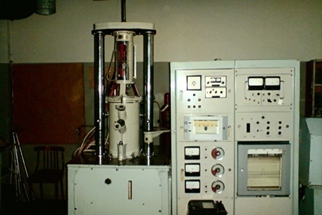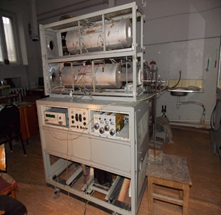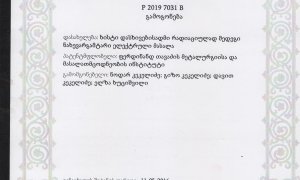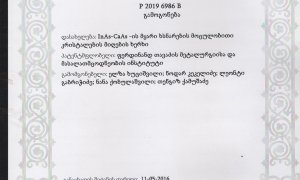The laboratory was founded in 1962 in order to process the technology of producing semiconductor materials in particular, Si-Ge solid solutions for their use in thermodynamics.
Laboratory works on the following problems:
- Processing of technologies and physical basis for creating new generation of radiation-resistant semiconductor materials;
- Analysis of contaminated water taken from Fukushima territory polluted with radioactive nuclides (Received from The International Atomic Energy Agency Vienna, Austria) and also monitoring of waters from the Black Sea region of Georgia and determination of radioactive gas- Radon concentration in Tbilisi;
Serious threat of radiation existing today demonstrates that the problem of radiation is still an issue of the day. Naturally the safety of the Country from radiation concerns Georgia as well. The most important problem in terms of radiation safety is connected to the creation of modern radiation resistant semiconductor materials and tools. The sensitivity of semiconductors’ properties to the changes in environmental conditions, in particular to the intensity of radioactive emanation determined the necessity of creating semiconductor materials with new properties. Irradiation changes properties of semiconductors and as a result causes deterioration of features of tools working in radioactive conditions. In conditions of prolonged exposure to the large dose of radiation semiconductor tools stop operating altogether, which is related to losses of hundreds of millions of dollars.
Semiconductor materials with main parameters, such as the concentration of electrons, the fundamental optical absorption edge and thermo-electric effectiveness, that can withstand large dose of irradiation were created in previous years (2015-2016) in the №6, Laboratory of Semiconductor Materials Science. Radiation resistant materials created by us can be successfully used in spacecraft and their power supply systems. They are also a necessary for creation of functional tools on nuclear power plants, nuclear reactors, accelerators and territories polluted with radiation. On the base of produced materials tools resistant to the strong radioactive irradiation will be created, in particular hall effect sensors for monitoring of magnetic field.
 |
 |
Commercial Suggestions:
Created radiation resistant materials can as well successfully be used in “normal” conditions on nuclear power plants, accelerators, reactors and territories polluted with radiation, including Chernobyl and Fukushima. Creation of radiation resistant materials is also necessary for Georgia, because:
1. These materials (and tools created on their base) can become a serious source of income for the Country as well as basis for international projects.
2. Up to 300 military bases of the former Soviet Union and special local territories some of which are polluted with radiation existed on the territory of Georgia.
3. Defense and security agencies of every Country (including Georgia) should possess radiation resistant materials and tools.
Analysis of contaminated water taken from Fukushima territory polluted with radioactive nuclides (Received from The International Atomic Energy Agency Vienna, Austria) and also monitoring of waters from the Black Sea region of Georgia and determination of radioactive gas- Radon concentration in Tbilisi.
Closely related to the problems of radiation security is estimation of radioactivity of environmental objects, in particular of natural and technogenic radioactivity of waters and radiological risk for the population and. Especially this concerns the radioactivity of water. Radioactivity of water is determined by existence of radioactive elements in it, which appear in water mainly from soil and rocks. Natural radioactive isotopes ((40K, 222Rn, 226Ra and others)as well as technogenic (mainly, 137Cs, 90Sr and others) which appeared as a result of nuclear explosions and crashes.
Content of natural radioactive elements in water depends on its type. Radioactivity of groundwater is mainly determined with Radon, Rn-222, which is easily collected in water from rocks due to its high solubility. Radon concentration in groundwater often reaches high marks; 10 – 105 ბეკერელ/ლ. Groundwater are often used as drinking water, which is why the content of radon in different types of water is a subject of many researches.
In surface waters (River, Lake, Sea and other) the content of Radon is much less due to a short half-life period (approx. 3.8 days). Concentration of other types of Radionuclides is much less due to small solubility in water and can be distinguished mainly by the amount of trace (example: Rn-222–0.04 და ნაკლებ ბეკერელ/ლ.).
Also monitoring of waters from the Black Sea region of Georgia and determination of radioactive gas- Radon concentration in Tbilisi.
Investigation of physical fundamentals of radiation donors and acceptors mutual compensation in solid solutions of InAs-III-V type semiconductor compounds and creation of samples of some devices
Resume
The goal of theme is the establishment of the nature of radiation donors and acceptors mutual compensation in in solid solutions of InAs-III-V type semiconductor compounds. At collision of high energy nuclear particles with the atoms of materials there develop very extremely complex processes, quantitative and qualitative analyses of which have not been implemented yet.
In our former works there has been shown, that because of developed under radiation phenomenon of radiation donors and acceptors mutual compensation in InAs and InP sublattices, InPxAs1-x alloys reveal radiation tolerance to the hard radiation.This phenomenon needs tobe explained in detail, obtaining new results snd scientific understanding. For this reason quantitative calculation will be implemented and established the way of producing the new generation of radiation-resistant semiconductor materials.

